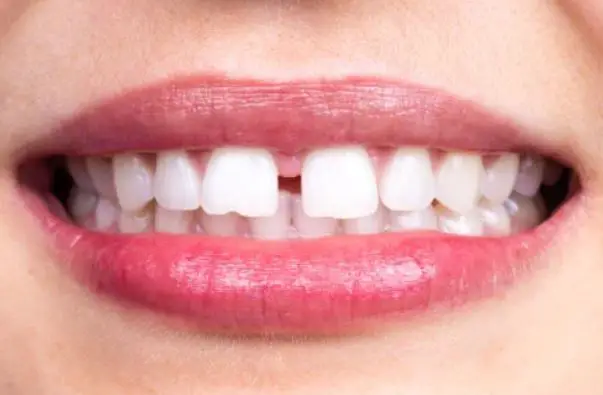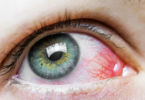When you hear about dental diastema, you may not be very sure what it is. In this article we clarify everything you need to know about excessive tooth separation.

Dental diastema is the term used to name the excessive separation between the teeth. That of the upper central incisors is the most common and the most visible. Also the best known, since there are many celebrities who are characterized by having it and wearing it with pride.
In this article we will tell you why it occurs and how it can be solved, if it is necessary. Keep reading and find out more.
What is the dental diastema?
As we mentioned, a dental diastema is the excessive space between two or more teeth that are widely separated from each other. The most common is among the upper central incisors.
But it can happen between any pair of teeth, both in temporary and permanent dentition. That is, in children and in adults.
Why does the dental diastema occur?
There are different factors that can lead to the presence of a dental diastema. The following are the most common causes:
Age: it is common to find this characteristic in young children, in the milk teething. It tends to correct itself naturally over time, closing with the eruption of the final pieces.
Genetics: it is a family characteristic that is passed from generation to generation.
Discrepancy between the size of the bone and that of the teeth: a very large jaw or very small teeth can cause spacing between the teeth.
Absence of a tooth: the lack of a tooth causes an excessive space with the next tooth.
Presence of an extra tooth: the so-called mesiodens is a supernumerary micro tooth with a conical or double cone shape that is located between the central incisors or behind them. Its presence, even if it remains retained inside the bone, causes the pieces to separate.
Very large or fibrous labial frenulum: This is the mucous membrane that extends from the inside of the lip to the gum tissue. When it is very large and fibrous, it can insert lower or deeper than normal and cause the central incisors to separate.
Tongue interposition: the habit of interposing or pushing the teeth with the tongue can lead to separation in the long term.
Trauma: a blow to the mouth not treated in a timely manner can lead to displacement of the teeth and create a gap.
Alterations of the bite: problems of oral alignment, horizontal overbite and protruding teeth cause dental diastemas.

Both children and adults can have dental diastema. The causes and treatments are differentiated.
Consequences of dental diastema
Many times, having a dental diastema does not pose any serious inconvenience other than the particular aspect that it gives to the smile. This is not a problem for some people. But others are embarrassed and can negatively affect their self-esteem and social relationships.
However, there are some more consequences that can be associated with the presence of a dental diastema. The increased risk of cavities and gingivitis in the teeth involved is an example. The space between teeth can favor the accumulation of bacterial plaque and food debris. If there is no proper oral hygiene, these diseases can develop.
Diastemas can be associated with occlusion problems that affect how the person bites. In addition, there is the possibility of suffering associated symptoms, such as headaches, ear, jaw and neck.
Speech disturbances are another possible consequence. The pronunciation of certain phonemes in which the anterior teeth intervene can be affected when they are separated.
What alternatives exist to correct it?
The first step to correct a dental diastema is to determine its cause and, based on it, plan the appropriate treatment. The dentist will be the one who will guide the patient on the most appropriate alternatives for each clinical case.
These are some of the therapeutic options:
Staying with the diastema: if the patient feels comfortable with the aesthetics of his smile, no function of the mouth is altered and there is no risk of other associated conditions, it is possible not to perform any intervention.
Close the space with orthodontics: with the use of orthodontic appliances, the teeth are mobilized to close the space between the teeth. Conventional, cosmetic, lingual or invisible braces can be used.
Fillings with resins: it is possible to reshape the teeth by adding aesthetic material based on resins that closes the space between the teeth.
Dental veneers: Porcelain veneers can be another solution. They adhere to the outside of the teeth, giving them a larger appearance, capable of closing excess space.
Crowns: through the placement of a dental crown it is possible to give a new shape and size to the tooth and thus close the excess space. The tooth is carved to receive it and it is placed and cemented as a plug that completely covers the piece.
Surgery: when the origin of the dental diastema is in the labial frenulum, through a surgical procedure called frenectomy it is cut and repositioned. If the cause is the presence of a mesiodens, it must also be surgically removed. When performing these interventions in children the space may close on its own. In adolescents and adults, on the other hand, the treatment has to be combined with orthodontics to complete the closure.
Repositioning of the traumatized tooth: in the event that the dental diastema is caused by trauma, the ideal is to act as soon as possible. The tooth should be anesthetized, the tooth repositioned in its correct location and fixed with splints for a time.

The use of dental veneers is an alternative treatment for diastema. These pieces cover the space, hiding it.
At ease with the smile
Having a dental diastema can mean an aesthetic problem, an obstacle to pronounce certain phonemes or a cause of embarrassment when smiling. In this case, consulting the dentist, searching for the origin and choosing the best available solution is recommended.
On the other hand, there are people who feel comfortable with the extra space in their teeth. They see it as a particular feature of their smile and wear it with pride.
Whatever the case, feeling good about your image is the main thing. And going to the trusted dentist to clear all the doubts that may arise regarding this alteration is the convenient thing to do. Thus, there will be no obstacles to showing the smile with confidence.





